Woolworth's SAP Implementation: A Case Study
VerifiedAdded on 2023/06/11
|12
|3614
|68
AI Summary
This case study discusses Woolworth's successful implementation of SAP ERP system. It explains the benefits of ERP systems and the importance of data migration and employee training. The article also covers the criteria for selecting an ERP vendor and the role of Business Process Reengineering (BPR) in ERP implementation.
Contribute Materials
Your contribution can guide someone’s learning journey. Share your
documents today.
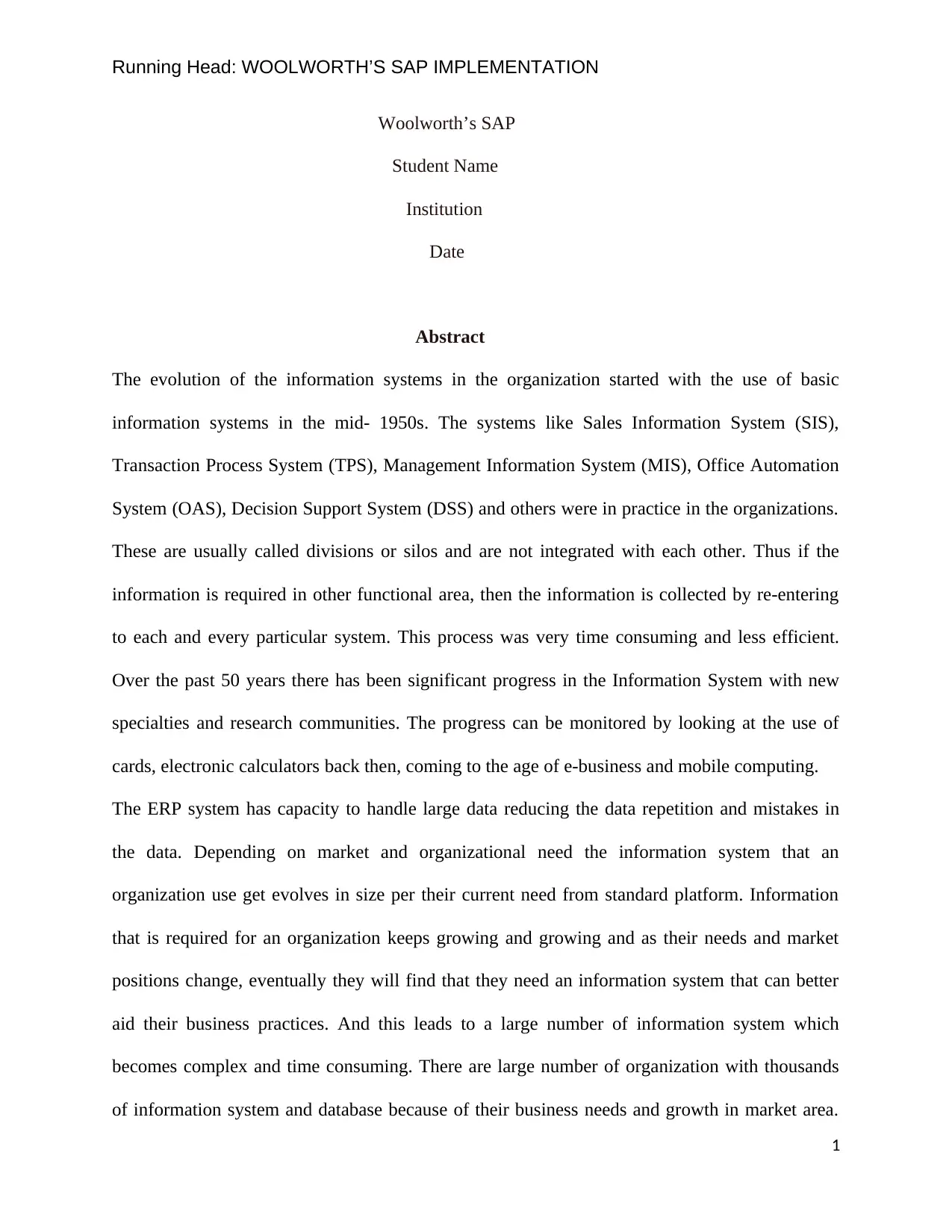
Running Head: WOOLWORTH’S SAP IMPLEMENTATION
Woolworth’s SAP
Student Name
Institution
Date
Abstract
The evolution of the information systems in the organization started with the use of basic
information systems in the mid- 1950s. The systems like Sales Information System (SIS),
Transaction Process System (TPS), Management Information System (MIS), Office Automation
System (OAS), Decision Support System (DSS) and others were in practice in the organizations.
These are usually called divisions or silos and are not integrated with each other. Thus if the
information is required in other functional area, then the information is collected by re-entering
to each and every particular system. This process was very time consuming and less efficient.
Over the past 50 years there has been significant progress in the Information System with new
specialties and research communities. The progress can be monitored by looking at the use of
cards, electronic calculators back then, coming to the age of e-business and mobile computing.
The ERP system has capacity to handle large data reducing the data repetition and mistakes in
the data. Depending on market and organizational need the information system that an
organization use get evolves in size per their current need from standard platform. Information
that is required for an organization keeps growing and growing and as their needs and market
positions change, eventually they will find that they need an information system that can better
aid their business practices. And this leads to a large number of information system which
becomes complex and time consuming. There are large number of organization with thousands
of information system and database because of their business needs and growth in market area.
1
Woolworth’s SAP
Student Name
Institution
Date
Abstract
The evolution of the information systems in the organization started with the use of basic
information systems in the mid- 1950s. The systems like Sales Information System (SIS),
Transaction Process System (TPS), Management Information System (MIS), Office Automation
System (OAS), Decision Support System (DSS) and others were in practice in the organizations.
These are usually called divisions or silos and are not integrated with each other. Thus if the
information is required in other functional area, then the information is collected by re-entering
to each and every particular system. This process was very time consuming and less efficient.
Over the past 50 years there has been significant progress in the Information System with new
specialties and research communities. The progress can be monitored by looking at the use of
cards, electronic calculators back then, coming to the age of e-business and mobile computing.
The ERP system has capacity to handle large data reducing the data repetition and mistakes in
the data. Depending on market and organizational need the information system that an
organization use get evolves in size per their current need from standard platform. Information
that is required for an organization keeps growing and growing and as their needs and market
positions change, eventually they will find that they need an information system that can better
aid their business practices. And this leads to a large number of information system which
becomes complex and time consuming. There are large number of organization with thousands
of information system and database because of their business needs and growth in market area.
1
Secure Best Marks with AI Grader
Need help grading? Try our AI Grader for instant feedback on your assignments.
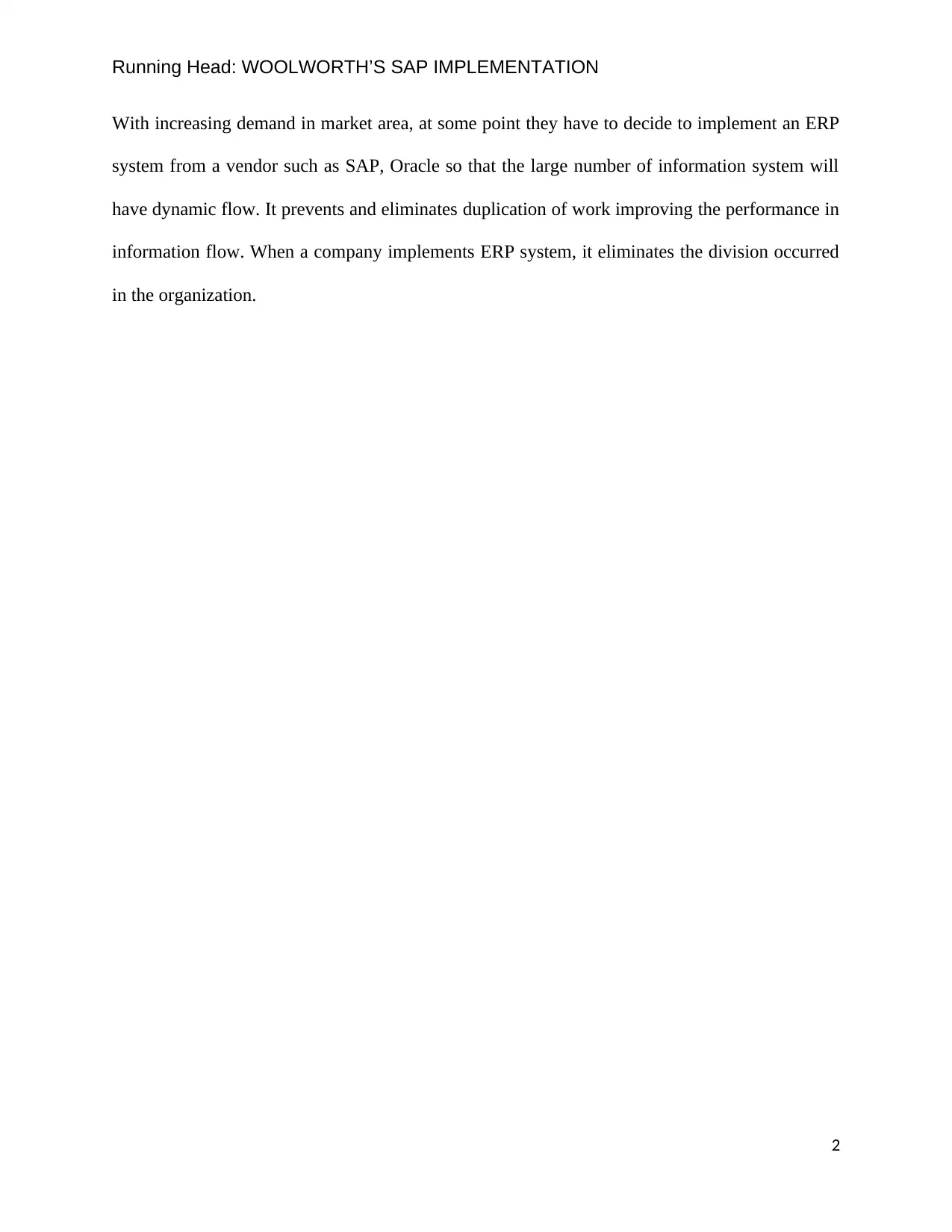
Running Head: WOOLWORTH’S SAP IMPLEMENTATION
With increasing demand in market area, at some point they have to decide to implement an ERP
system from a vendor such as SAP, Oracle so that the large number of information system will
have dynamic flow. It prevents and eliminates duplication of work improving the performance in
information flow. When a company implements ERP system, it eliminates the division occurred
in the organization.
2
With increasing demand in market area, at some point they have to decide to implement an ERP
system from a vendor such as SAP, Oracle so that the large number of information system will
have dynamic flow. It prevents and eliminates duplication of work improving the performance in
information flow. When a company implements ERP system, it eliminates the division occurred
in the organization.
2
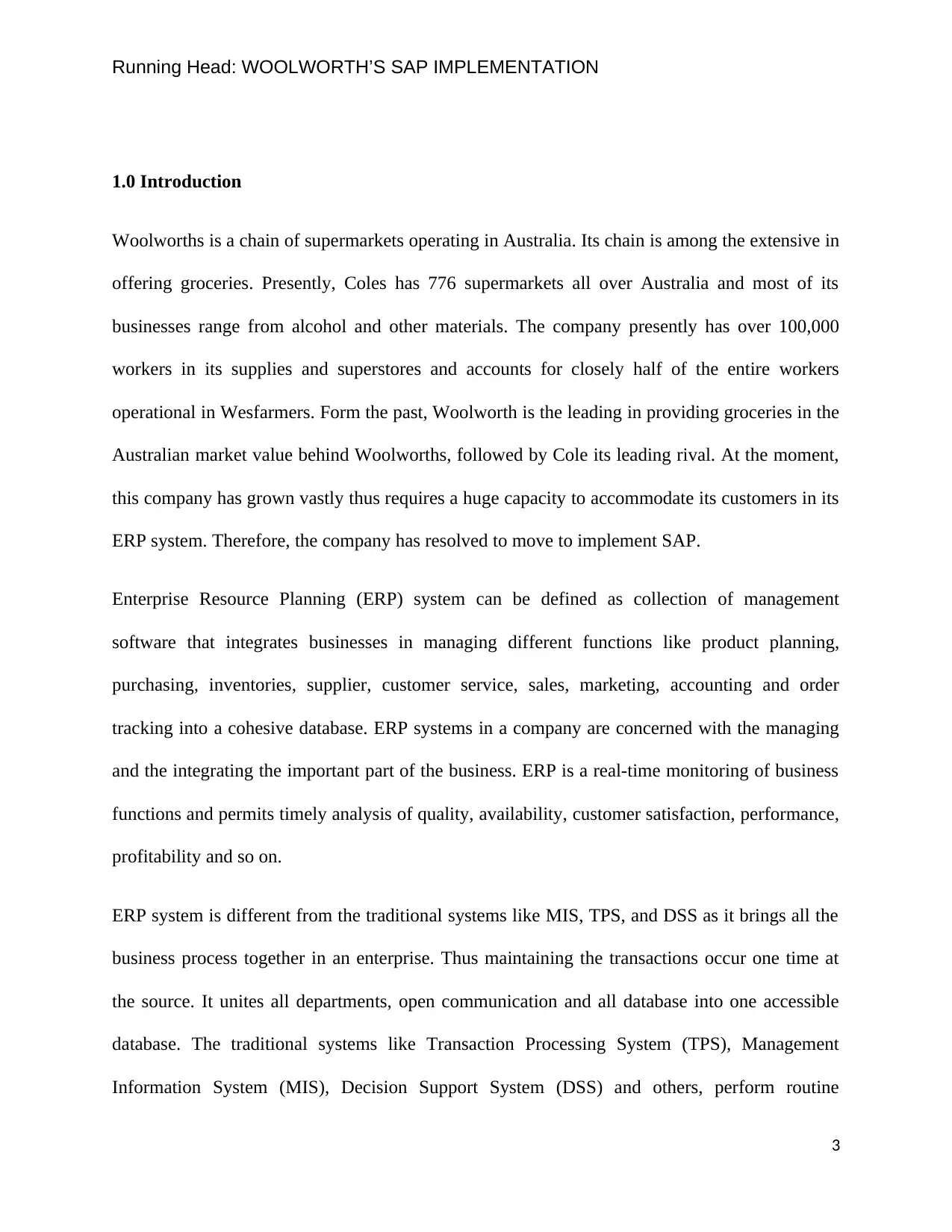
Running Head: WOOLWORTH’S SAP IMPLEMENTATION
1.0 Introduction
Woolworths is a chain of supermarkets operating in Australia. Its chain is among the extensive in
offering groceries. Presently, Coles has 776 supermarkets all over Australia and most of its
businesses range from alcohol and other materials. The company presently has over 100,000
workers in its supplies and superstores and accounts for closely half of the entire workers
operational in Wesfarmers. Form the past, Woolworth is the leading in providing groceries in the
Australian market value behind Woolworths, followed by Cole its leading rival. At the moment,
this company has grown vastly thus requires a huge capacity to accommodate its customers in its
ERP system. Therefore, the company has resolved to move to implement SAP.
Enterprise Resource Planning (ERP) system can be defined as collection of management
software that integrates businesses in managing different functions like product planning,
purchasing, inventories, supplier, customer service, sales, marketing, accounting and order
tracking into a cohesive database. ERP systems in a company are concerned with the managing
and the integrating the important part of the business. ERP is a real-time monitoring of business
functions and permits timely analysis of quality, availability, customer satisfaction, performance,
profitability and so on.
ERP system is different from the traditional systems like MIS, TPS, and DSS as it brings all the
business process together in an enterprise. Thus maintaining the transactions occur one time at
the source. It unites all departments, open communication and all database into one accessible
database. The traditional systems like Transaction Processing System (TPS), Management
Information System (MIS), Decision Support System (DSS) and others, perform routine
3
1.0 Introduction
Woolworths is a chain of supermarkets operating in Australia. Its chain is among the extensive in
offering groceries. Presently, Coles has 776 supermarkets all over Australia and most of its
businesses range from alcohol and other materials. The company presently has over 100,000
workers in its supplies and superstores and accounts for closely half of the entire workers
operational in Wesfarmers. Form the past, Woolworth is the leading in providing groceries in the
Australian market value behind Woolworths, followed by Cole its leading rival. At the moment,
this company has grown vastly thus requires a huge capacity to accommodate its customers in its
ERP system. Therefore, the company has resolved to move to implement SAP.
Enterprise Resource Planning (ERP) system can be defined as collection of management
software that integrates businesses in managing different functions like product planning,
purchasing, inventories, supplier, customer service, sales, marketing, accounting and order
tracking into a cohesive database. ERP systems in a company are concerned with the managing
and the integrating the important part of the business. ERP is a real-time monitoring of business
functions and permits timely analysis of quality, availability, customer satisfaction, performance,
profitability and so on.
ERP system is different from the traditional systems like MIS, TPS, and DSS as it brings all the
business process together in an enterprise. Thus maintaining the transactions occur one time at
the source. It unites all departments, open communication and all database into one accessible
database. The traditional systems like Transaction Processing System (TPS), Management
Information System (MIS), Decision Support System (DSS) and others, perform routine
3
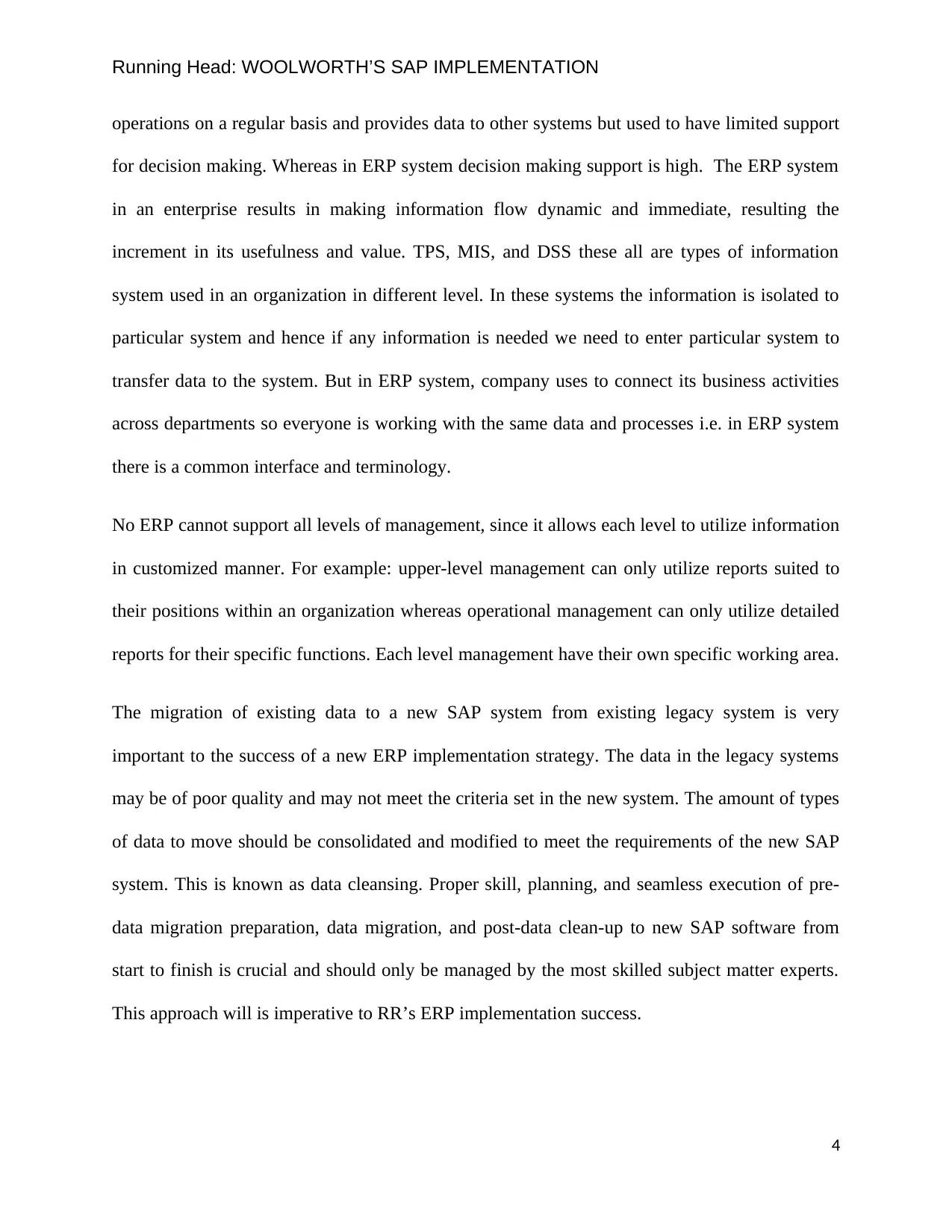
Running Head: WOOLWORTH’S SAP IMPLEMENTATION
operations on a regular basis and provides data to other systems but used to have limited support
for decision making. Whereas in ERP system decision making support is high. The ERP system
in an enterprise results in making information flow dynamic and immediate, resulting the
increment in its usefulness and value. TPS, MIS, and DSS these all are types of information
system used in an organization in different level. In these systems the information is isolated to
particular system and hence if any information is needed we need to enter particular system to
transfer data to the system. But in ERP system, company uses to connect its business activities
across departments so everyone is working with the same data and processes i.e. in ERP system
there is a common interface and terminology.
No ERP cannot support all levels of management, since it allows each level to utilize information
in customized manner. For example: upper-level management can only utilize reports suited to
their positions within an organization whereas operational management can only utilize detailed
reports for their specific functions. Each level management have their own specific working area.
The migration of existing data to a new SAP system from existing legacy system is very
important to the success of a new ERP implementation strategy. The data in the legacy systems
may be of poor quality and may not meet the criteria set in the new system. The amount of types
of data to move should be consolidated and modified to meet the requirements of the new SAP
system. This is known as data cleansing. Proper skill, planning, and seamless execution of pre-
data migration preparation, data migration, and post-data clean-up to new SAP software from
start to finish is crucial and should only be managed by the most skilled subject matter experts.
This approach will is imperative to RR’s ERP implementation success.
4
operations on a regular basis and provides data to other systems but used to have limited support
for decision making. Whereas in ERP system decision making support is high. The ERP system
in an enterprise results in making information flow dynamic and immediate, resulting the
increment in its usefulness and value. TPS, MIS, and DSS these all are types of information
system used in an organization in different level. In these systems the information is isolated to
particular system and hence if any information is needed we need to enter particular system to
transfer data to the system. But in ERP system, company uses to connect its business activities
across departments so everyone is working with the same data and processes i.e. in ERP system
there is a common interface and terminology.
No ERP cannot support all levels of management, since it allows each level to utilize information
in customized manner. For example: upper-level management can only utilize reports suited to
their positions within an organization whereas operational management can only utilize detailed
reports for their specific functions. Each level management have their own specific working area.
The migration of existing data to a new SAP system from existing legacy system is very
important to the success of a new ERP implementation strategy. The data in the legacy systems
may be of poor quality and may not meet the criteria set in the new system. The amount of types
of data to move should be consolidated and modified to meet the requirements of the new SAP
system. This is known as data cleansing. Proper skill, planning, and seamless execution of pre-
data migration preparation, data migration, and post-data clean-up to new SAP software from
start to finish is crucial and should only be managed by the most skilled subject matter experts.
This approach will is imperative to RR’s ERP implementation success.
4
Secure Best Marks with AI Grader
Need help grading? Try our AI Grader for instant feedback on your assignments.
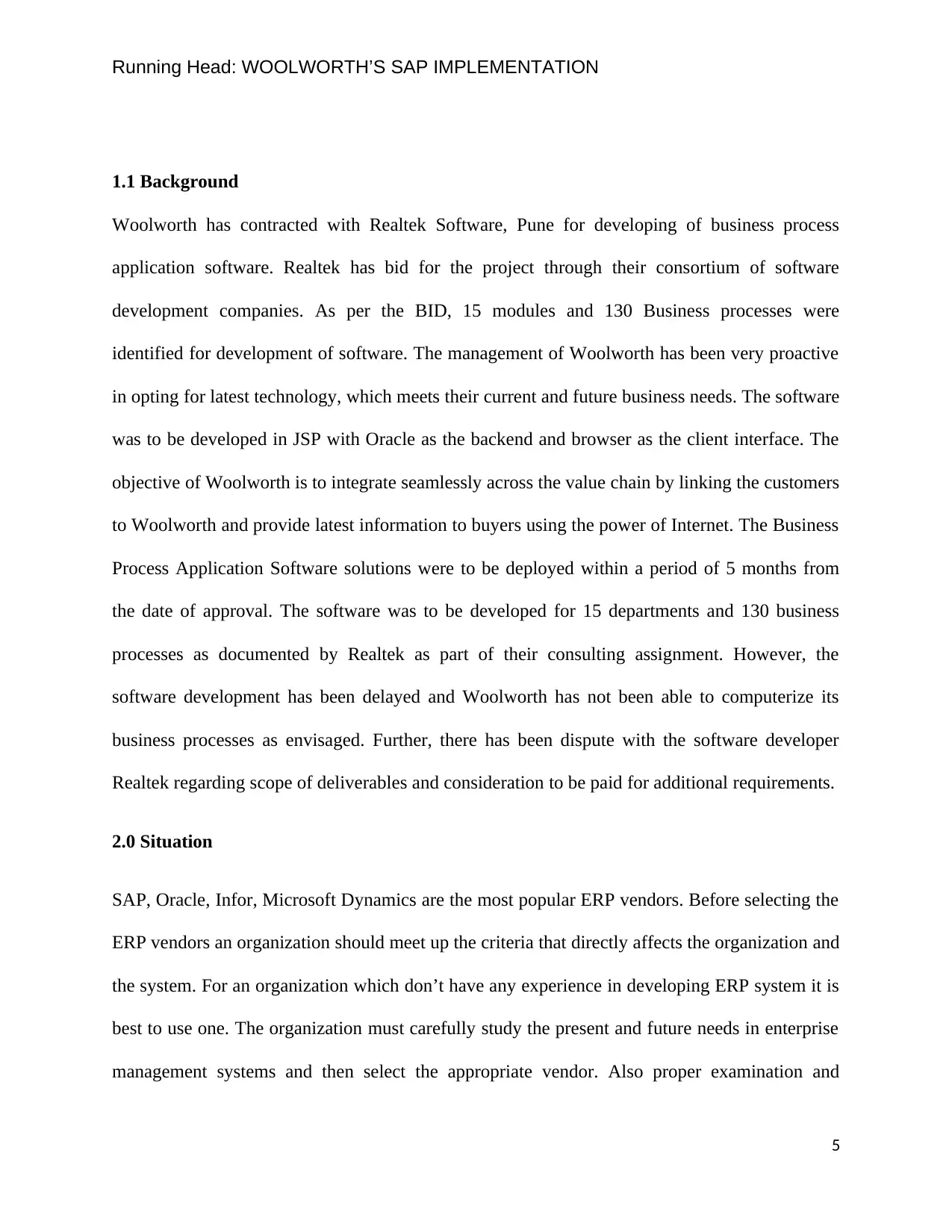
Running Head: WOOLWORTH’S SAP IMPLEMENTATION
1.1 Background
Woolworth has contracted with Realtek Software, Pune for developing of business process
application software. Realtek has bid for the project through their consortium of software
development companies. As per the BID, 15 modules and 130 Business processes were
identified for development of software. The management of Woolworth has been very proactive
in opting for latest technology, which meets their current and future business needs. The software
was to be developed in JSP with Oracle as the backend and browser as the client interface. The
objective of Woolworth is to integrate seamlessly across the value chain by linking the customers
to Woolworth and provide latest information to buyers using the power of Internet. The Business
Process Application Software solutions were to be deployed within a period of 5 months from
the date of approval. The software was to be developed for 15 departments and 130 business
processes as documented by Realtek as part of their consulting assignment. However, the
software development has been delayed and Woolworth has not been able to computerize its
business processes as envisaged. Further, there has been dispute with the software developer
Realtek regarding scope of deliverables and consideration to be paid for additional requirements.
2.0 Situation
SAP, Oracle, Infor, Microsoft Dynamics are the most popular ERP vendors. Before selecting the
ERP vendors an organization should meet up the criteria that directly affects the organization and
the system. For an organization which don’t have any experience in developing ERP system it is
best to use one. The organization must carefully study the present and future needs in enterprise
management systems and then select the appropriate vendor. Also proper examination and
5
1.1 Background
Woolworth has contracted with Realtek Software, Pune for developing of business process
application software. Realtek has bid for the project through their consortium of software
development companies. As per the BID, 15 modules and 130 Business processes were
identified for development of software. The management of Woolworth has been very proactive
in opting for latest technology, which meets their current and future business needs. The software
was to be developed in JSP with Oracle as the backend and browser as the client interface. The
objective of Woolworth is to integrate seamlessly across the value chain by linking the customers
to Woolworth and provide latest information to buyers using the power of Internet. The Business
Process Application Software solutions were to be deployed within a period of 5 months from
the date of approval. The software was to be developed for 15 departments and 130 business
processes as documented by Realtek as part of their consulting assignment. However, the
software development has been delayed and Woolworth has not been able to computerize its
business processes as envisaged. Further, there has been dispute with the software developer
Realtek regarding scope of deliverables and consideration to be paid for additional requirements.
2.0 Situation
SAP, Oracle, Infor, Microsoft Dynamics are the most popular ERP vendors. Before selecting the
ERP vendors an organization should meet up the criteria that directly affects the organization and
the system. For an organization which don’t have any experience in developing ERP system it is
best to use one. The organization must carefully study the present and future needs in enterprise
management systems and then select the appropriate vendor. Also proper examination and
5
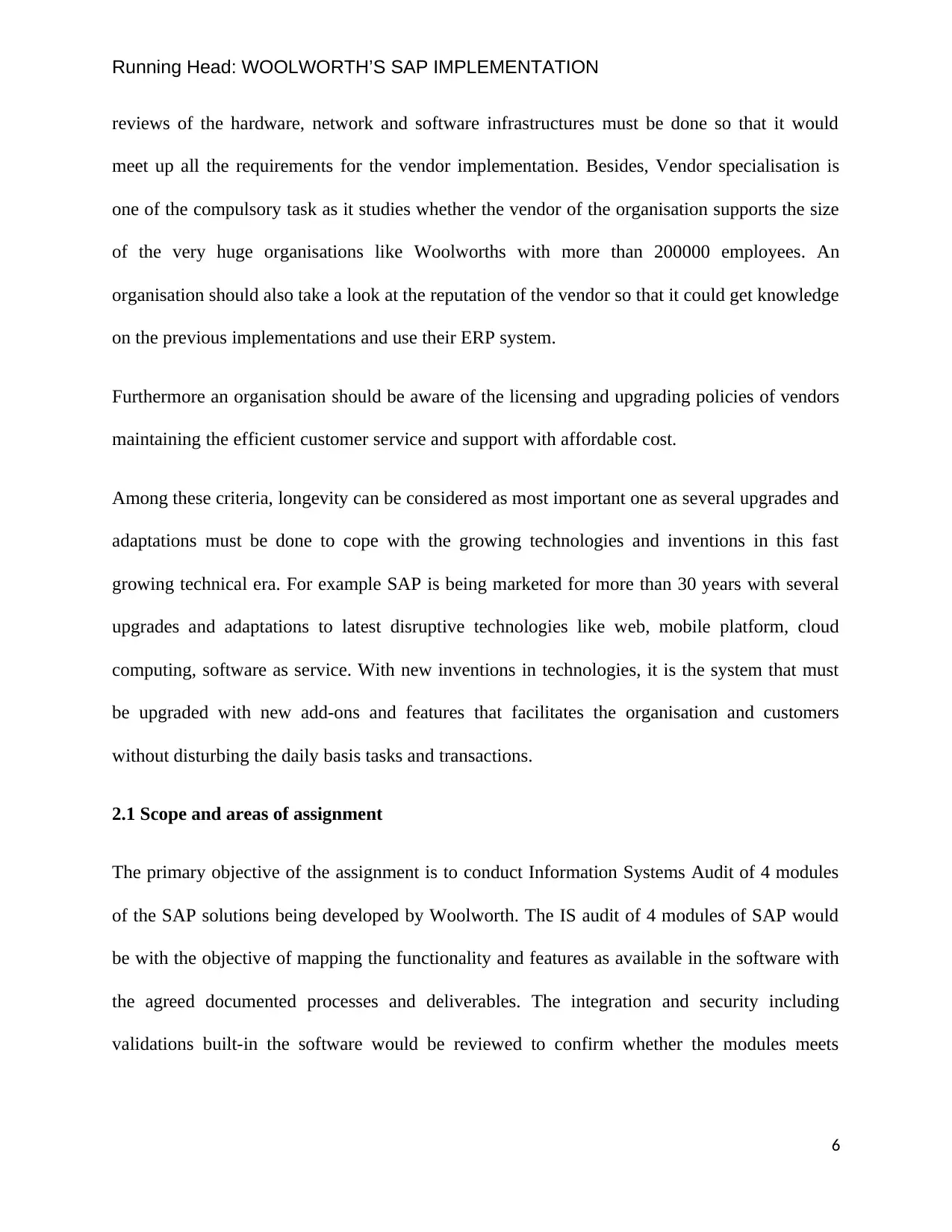
Running Head: WOOLWORTH’S SAP IMPLEMENTATION
reviews of the hardware, network and software infrastructures must be done so that it would
meet up all the requirements for the vendor implementation. Besides, Vendor specialisation is
one of the compulsory task as it studies whether the vendor of the organisation supports the size
of the very huge organisations like Woolworths with more than 200000 employees. An
organisation should also take a look at the reputation of the vendor so that it could get knowledge
on the previous implementations and use their ERP system.
Furthermore an organisation should be aware of the licensing and upgrading policies of vendors
maintaining the efficient customer service and support with affordable cost.
Among these criteria, longevity can be considered as most important one as several upgrades and
adaptations must be done to cope with the growing technologies and inventions in this fast
growing technical era. For example SAP is being marketed for more than 30 years with several
upgrades and adaptations to latest disruptive technologies like web, mobile platform, cloud
computing, software as service. With new inventions in technologies, it is the system that must
be upgraded with new add-ons and features that facilitates the organisation and customers
without disturbing the daily basis tasks and transactions.
2.1 Scope and areas of assignment
The primary objective of the assignment is to conduct Information Systems Audit of 4 modules
of the SAP solutions being developed by Woolworth. The IS audit of 4 modules of SAP would
be with the objective of mapping the functionality and features as available in the software with
the agreed documented processes and deliverables. The integration and security including
validations built-in the software would be reviewed to confirm whether the modules meets
6
reviews of the hardware, network and software infrastructures must be done so that it would
meet up all the requirements for the vendor implementation. Besides, Vendor specialisation is
one of the compulsory task as it studies whether the vendor of the organisation supports the size
of the very huge organisations like Woolworths with more than 200000 employees. An
organisation should also take a look at the reputation of the vendor so that it could get knowledge
on the previous implementations and use their ERP system.
Furthermore an organisation should be aware of the licensing and upgrading policies of vendors
maintaining the efficient customer service and support with affordable cost.
Among these criteria, longevity can be considered as most important one as several upgrades and
adaptations must be done to cope with the growing technologies and inventions in this fast
growing technical era. For example SAP is being marketed for more than 30 years with several
upgrades and adaptations to latest disruptive technologies like web, mobile platform, cloud
computing, software as service. With new inventions in technologies, it is the system that must
be upgraded with new add-ons and features that facilitates the organisation and customers
without disturbing the daily basis tasks and transactions.
2.1 Scope and areas of assignment
The primary objective of the assignment is to conduct Information Systems Audit of 4 modules
of the SAP solutions being developed by Woolworth. The IS audit of 4 modules of SAP would
be with the objective of mapping the functionality and features as available in the software with
the agreed documented processes and deliverables. The integration and security including
validations built-in the software would be reviewed to confirm whether the modules meets
6
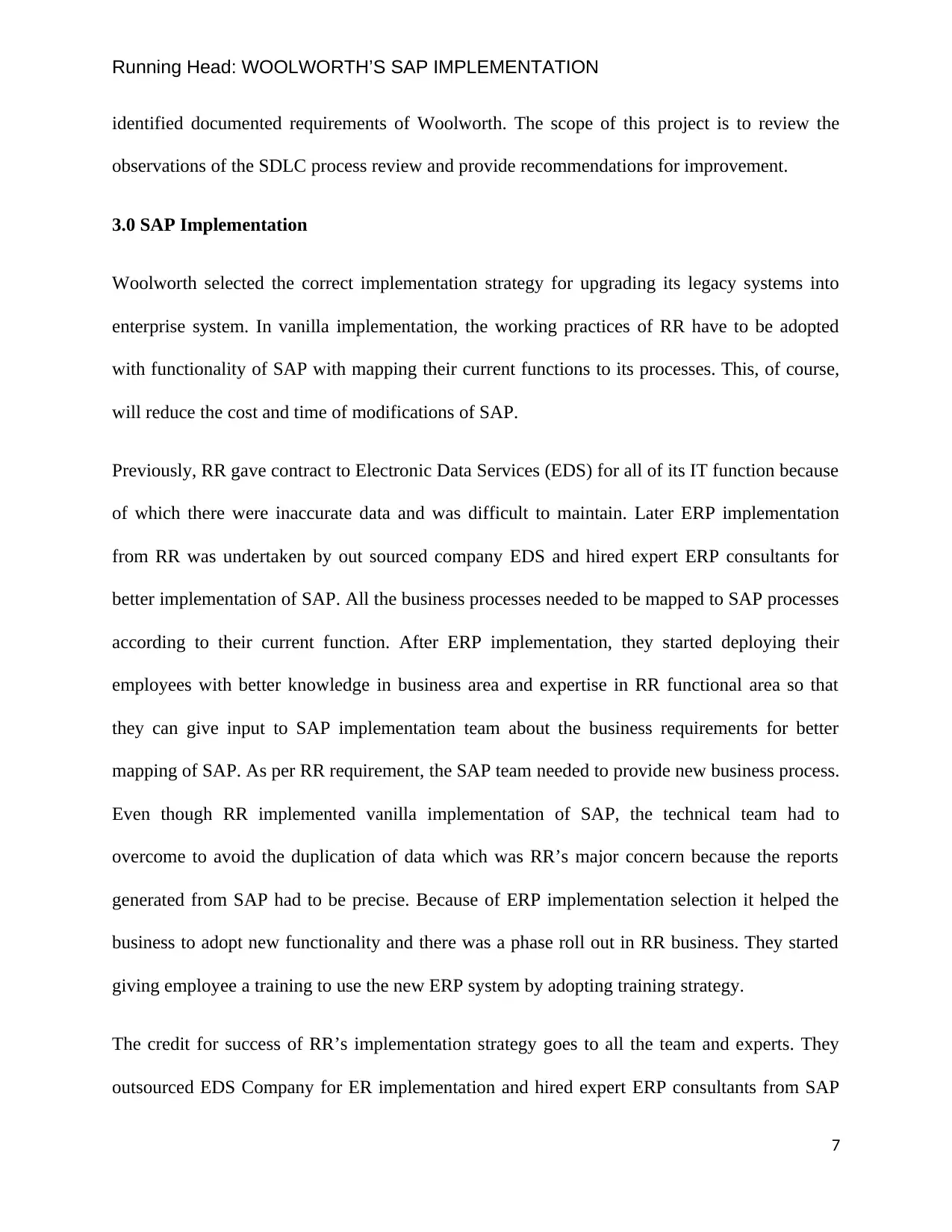
Running Head: WOOLWORTH’S SAP IMPLEMENTATION
identified documented requirements of Woolworth. The scope of this project is to review the
observations of the SDLC process review and provide recommendations for improvement.
3.0 SAP Implementation
Woolworth selected the correct implementation strategy for upgrading its legacy systems into
enterprise system. In vanilla implementation, the working practices of RR have to be adopted
with functionality of SAP with mapping their current functions to its processes. This, of course,
will reduce the cost and time of modifications of SAP.
Previously, RR gave contract to Electronic Data Services (EDS) for all of its IT function because
of which there were inaccurate data and was difficult to maintain. Later ERP implementation
from RR was undertaken by out sourced company EDS and hired expert ERP consultants for
better implementation of SAP. All the business processes needed to be mapped to SAP processes
according to their current function. After ERP implementation, they started deploying their
employees with better knowledge in business area and expertise in RR functional area so that
they can give input to SAP implementation team about the business requirements for better
mapping of SAP. As per RR requirement, the SAP team needed to provide new business process.
Even though RR implemented vanilla implementation of SAP, the technical team had to
overcome to avoid the duplication of data which was RR’s major concern because the reports
generated from SAP had to be precise. Because of ERP implementation selection it helped the
business to adopt new functionality and there was a phase roll out in RR business. They started
giving employee a training to use the new ERP system by adopting training strategy.
The credit for success of RR’s implementation strategy goes to all the team and experts. They
outsourced EDS Company for ER implementation and hired expert ERP consultants from SAP
7
identified documented requirements of Woolworth. The scope of this project is to review the
observations of the SDLC process review and provide recommendations for improvement.
3.0 SAP Implementation
Woolworth selected the correct implementation strategy for upgrading its legacy systems into
enterprise system. In vanilla implementation, the working practices of RR have to be adopted
with functionality of SAP with mapping their current functions to its processes. This, of course,
will reduce the cost and time of modifications of SAP.
Previously, RR gave contract to Electronic Data Services (EDS) for all of its IT function because
of which there were inaccurate data and was difficult to maintain. Later ERP implementation
from RR was undertaken by out sourced company EDS and hired expert ERP consultants for
better implementation of SAP. All the business processes needed to be mapped to SAP processes
according to their current function. After ERP implementation, they started deploying their
employees with better knowledge in business area and expertise in RR functional area so that
they can give input to SAP implementation team about the business requirements for better
mapping of SAP. As per RR requirement, the SAP team needed to provide new business process.
Even though RR implemented vanilla implementation of SAP, the technical team had to
overcome to avoid the duplication of data which was RR’s major concern because the reports
generated from SAP had to be precise. Because of ERP implementation selection it helped the
business to adopt new functionality and there was a phase roll out in RR business. They started
giving employee a training to use the new ERP system by adopting training strategy.
The credit for success of RR’s implementation strategy goes to all the team and experts. They
outsourced EDS Company for ER implementation and hired expert ERP consultants from SAP
7
Paraphrase This Document
Need a fresh take? Get an instant paraphrase of this document with our AI Paraphraser
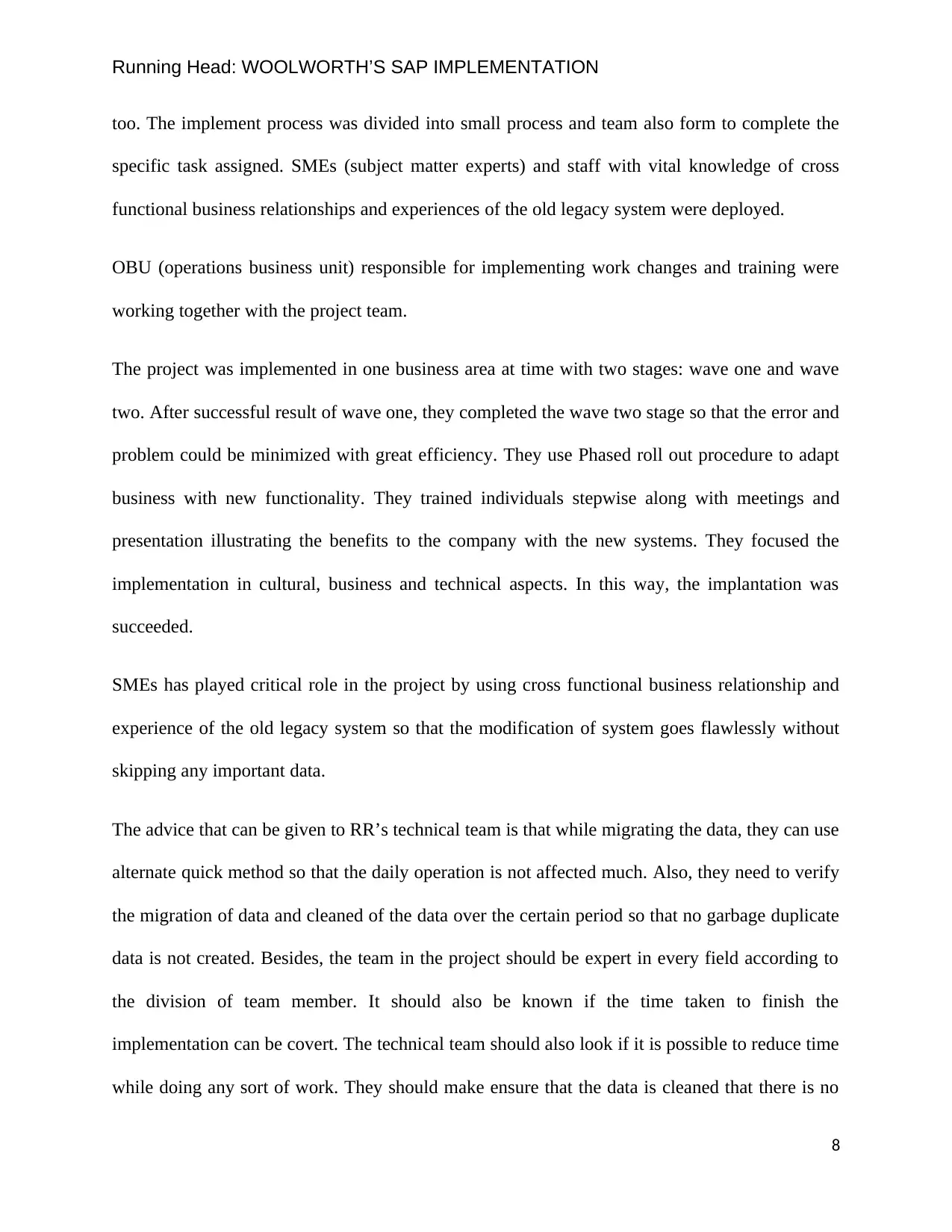
Running Head: WOOLWORTH’S SAP IMPLEMENTATION
too. The implement process was divided into small process and team also form to complete the
specific task assigned. SMEs (subject matter experts) and staff with vital knowledge of cross
functional business relationships and experiences of the old legacy system were deployed.
OBU (operations business unit) responsible for implementing work changes and training were
working together with the project team.
The project was implemented in one business area at time with two stages: wave one and wave
two. After successful result of wave one, they completed the wave two stage so that the error and
problem could be minimized with great efficiency. They use Phased roll out procedure to adapt
business with new functionality. They trained individuals stepwise along with meetings and
presentation illustrating the benefits to the company with the new systems. They focused the
implementation in cultural, business and technical aspects. In this way, the implantation was
succeeded.
SMEs has played critical role in the project by using cross functional business relationship and
experience of the old legacy system so that the modification of system goes flawlessly without
skipping any important data.
The advice that can be given to RR’s technical team is that while migrating the data, they can use
alternate quick method so that the daily operation is not affected much. Also, they need to verify
the migration of data and cleaned of the data over the certain period so that no garbage duplicate
data is not created. Besides, the team in the project should be expert in every field according to
the division of team member. It should also be known if the time taken to finish the
implementation can be covert. The technical team should also look if it is possible to reduce time
while doing any sort of work. They should make ensure that the data is cleaned that there is no
8
too. The implement process was divided into small process and team also form to complete the
specific task assigned. SMEs (subject matter experts) and staff with vital knowledge of cross
functional business relationships and experiences of the old legacy system were deployed.
OBU (operations business unit) responsible for implementing work changes and training were
working together with the project team.
The project was implemented in one business area at time with two stages: wave one and wave
two. After successful result of wave one, they completed the wave two stage so that the error and
problem could be minimized with great efficiency. They use Phased roll out procedure to adapt
business with new functionality. They trained individuals stepwise along with meetings and
presentation illustrating the benefits to the company with the new systems. They focused the
implementation in cultural, business and technical aspects. In this way, the implantation was
succeeded.
SMEs has played critical role in the project by using cross functional business relationship and
experience of the old legacy system so that the modification of system goes flawlessly without
skipping any important data.
The advice that can be given to RR’s technical team is that while migrating the data, they can use
alternate quick method so that the daily operation is not affected much. Also, they need to verify
the migration of data and cleaned of the data over the certain period so that no garbage duplicate
data is not created. Besides, the team in the project should be expert in every field according to
the division of team member. It should also be known if the time taken to finish the
implementation can be covert. The technical team should also look if it is possible to reduce time
while doing any sort of work. They should make ensure that the data is cleaned that there is no
8

Running Head: WOOLWORTH’S SAP IMPLEMENTATION
any error or inaccurate data. They should also avoid any duplication of data which was the major
concern of RR. The technical team should look after all the system so that there won’t be any
technical challenge after migrating from legacy system to the SAP software.
4.0 SAP Requirements
ERP systems integrate all data and processes of an organization into a unified system. A typical
ERP will use multiple components of computer software and hardware to achieve the integration.
A key ingredient of most ERP systems is the use of a unified database to store data for the
various system modules. In an organization it can be viewed as the system to run and handle all
the daily works and data on daily basis with full efficiency and escaping the data redundancy. An
ERP software solution seeks to streamline and integrate operations, processes and information
flows in an enterprise. The role of an ERP in organizations is to integrate departments and allow
them to function as a single infrastructure that serves the needs of each department.
A BPR is the process of a group of activities or tasks that has been coordinated to achieve a
business goal. When an organization implement an ERP system it does brings forth Business
Process Reengineering (BPR).
Among the different components of ERP system people factors can be termed as most critical
component in the implementation process. As the organisation is run by the people and the
system and the business is also remains under the employees. Employees at different levels and
management are the users and this directly affects the ERP system. The implementation directly
depends on how much knowledge the employees has about this system and the level of interest
and effort they show on using the system. The decision to implement an ERP systems will be of
the employees and also the willingness to change the business practices using this system. An
9
any error or inaccurate data. They should also avoid any duplication of data which was the major
concern of RR. The technical team should look after all the system so that there won’t be any
technical challenge after migrating from legacy system to the SAP software.
4.0 SAP Requirements
ERP systems integrate all data and processes of an organization into a unified system. A typical
ERP will use multiple components of computer software and hardware to achieve the integration.
A key ingredient of most ERP systems is the use of a unified database to store data for the
various system modules. In an organization it can be viewed as the system to run and handle all
the daily works and data on daily basis with full efficiency and escaping the data redundancy. An
ERP software solution seeks to streamline and integrate operations, processes and information
flows in an enterprise. The role of an ERP in organizations is to integrate departments and allow
them to function as a single infrastructure that serves the needs of each department.
A BPR is the process of a group of activities or tasks that has been coordinated to achieve a
business goal. When an organization implement an ERP system it does brings forth Business
Process Reengineering (BPR).
Among the different components of ERP system people factors can be termed as most critical
component in the implementation process. As the organisation is run by the people and the
system and the business is also remains under the employees. Employees at different levels and
management are the users and this directly affects the ERP system. The implementation directly
depends on how much knowledge the employees has about this system and the level of interest
and effort they show on using the system. The decision to implement an ERP systems will be of
the employees and also the willingness to change the business practices using this system. An
9

Running Head: WOOLWORTH’S SAP IMPLEMENTATION
ERP system will be successful only when the people in the organisation are willing to accept the
possibility to change and business reform.
4.1 Critical Factors
Critical success factors are defined as “those characteristics, conditions or variables that, when
properly sustained, maintained, or managed, can have a significant impact on the success of a
firm competing in particular industry” (Leidecker, 1984).The various teams that were created to
mitigate the associated issues that the new SAP/R3 system presented were highly skilled and
trained experts. The critical success factors of top management support with effective clear
goals, objectives, and clear communication was met first. The next steps in the implementation
required the subject matter experts to coordinate change management, business process
reengineering with minimum software customization, monitoring, and evaluating of
performance. Were all achieved. The SMEs were able to identify the issues and holdups to make
it an easier overall ERP implementation. Using the SMEs to handle the change management of
the ERP implementation strategy greatly benefitted Woolworth.
Computing technologies, and especially expert systems, are integral part of any business, as they
have a way of improving the operations undertaken in a business (Nordmeyer, n.d, n.p). For
Woolworths, which is an e-commerce retail store, there is a great need to invest in computing
applications that will improve its sales, and increase the customer satisfaction. Some of the
enterprise systems Woolworths can implement are Customer Relationship Management (CRM)
and Enterprise Resource Planning (ERP) systems, which can be helpful in increasing sales,
attracting new customers, and improving the customer support (Nordmeyer, n.d, n.p).
10
ERP system will be successful only when the people in the organisation are willing to accept the
possibility to change and business reform.
4.1 Critical Factors
Critical success factors are defined as “those characteristics, conditions or variables that, when
properly sustained, maintained, or managed, can have a significant impact on the success of a
firm competing in particular industry” (Leidecker, 1984).The various teams that were created to
mitigate the associated issues that the new SAP/R3 system presented were highly skilled and
trained experts. The critical success factors of top management support with effective clear
goals, objectives, and clear communication was met first. The next steps in the implementation
required the subject matter experts to coordinate change management, business process
reengineering with minimum software customization, monitoring, and evaluating of
performance. Were all achieved. The SMEs were able to identify the issues and holdups to make
it an easier overall ERP implementation. Using the SMEs to handle the change management of
the ERP implementation strategy greatly benefitted Woolworth.
Computing technologies, and especially expert systems, are integral part of any business, as they
have a way of improving the operations undertaken in a business (Nordmeyer, n.d, n.p). For
Woolworths, which is an e-commerce retail store, there is a great need to invest in computing
applications that will improve its sales, and increase the customer satisfaction. Some of the
enterprise systems Woolworths can implement are Customer Relationship Management (CRM)
and Enterprise Resource Planning (ERP) systems, which can be helpful in increasing sales,
attracting new customers, and improving the customer support (Nordmeyer, n.d, n.p).
10
Secure Best Marks with AI Grader
Need help grading? Try our AI Grader for instant feedback on your assignments.
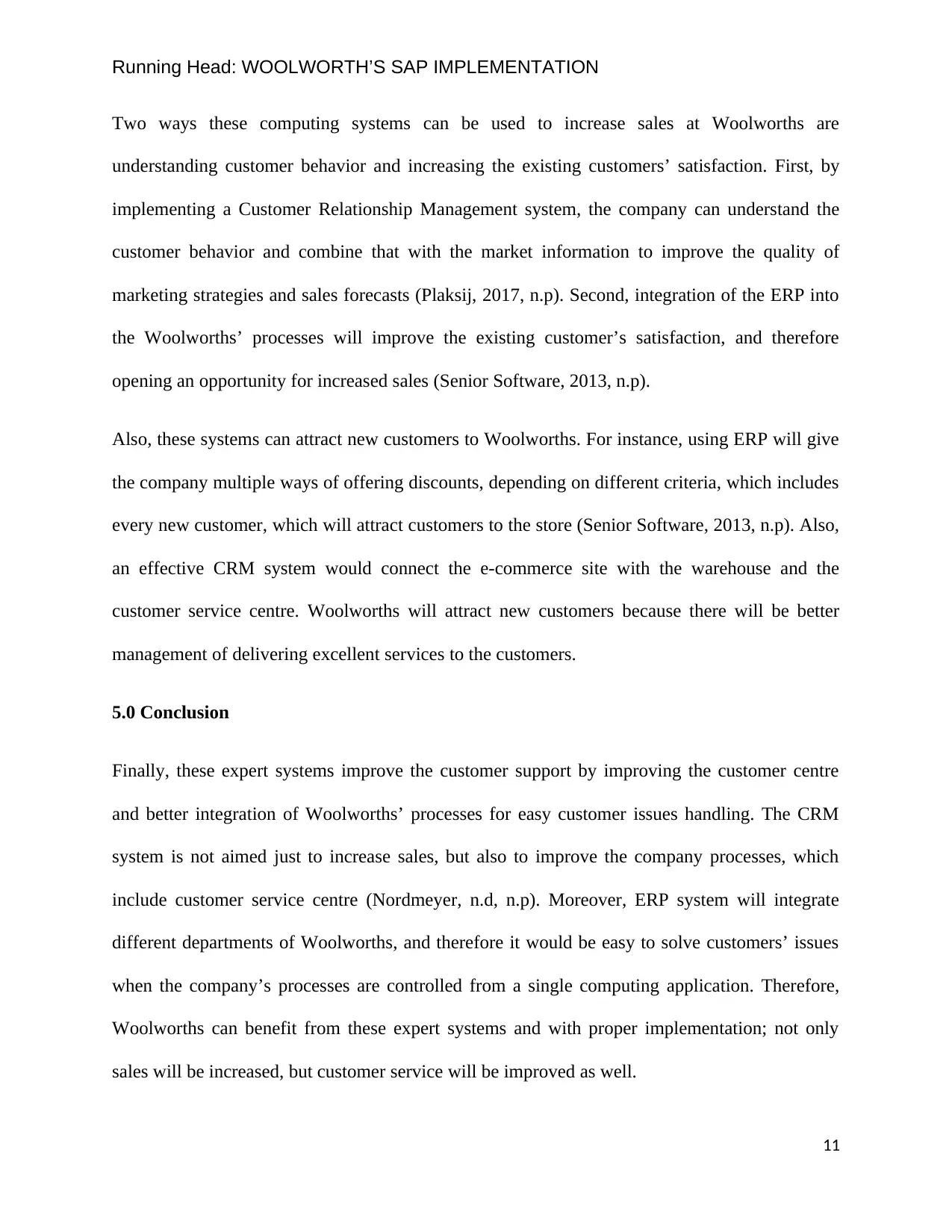
Running Head: WOOLWORTH’S SAP IMPLEMENTATION
Two ways these computing systems can be used to increase sales at Woolworths are
understanding customer behavior and increasing the existing customers’ satisfaction. First, by
implementing a Customer Relationship Management system, the company can understand the
customer behavior and combine that with the market information to improve the quality of
marketing strategies and sales forecasts (Plaksij, 2017, n.p). Second, integration of the ERP into
the Woolworths’ processes will improve the existing customer’s satisfaction, and therefore
opening an opportunity for increased sales (Senior Software, 2013, n.p).
Also, these systems can attract new customers to Woolworths. For instance, using ERP will give
the company multiple ways of offering discounts, depending on different criteria, which includes
every new customer, which will attract customers to the store (Senior Software, 2013, n.p). Also,
an effective CRM system would connect the e-commerce site with the warehouse and the
customer service centre. Woolworths will attract new customers because there will be better
management of delivering excellent services to the customers.
5.0 Conclusion
Finally, these expert systems improve the customer support by improving the customer centre
and better integration of Woolworths’ processes for easy customer issues handling. The CRM
system is not aimed just to increase sales, but also to improve the company processes, which
include customer service centre (Nordmeyer, n.d, n.p). Moreover, ERP system will integrate
different departments of Woolworths, and therefore it would be easy to solve customers’ issues
when the company’s processes are controlled from a single computing application. Therefore,
Woolworths can benefit from these expert systems and with proper implementation; not only
sales will be increased, but customer service will be improved as well.
11
Two ways these computing systems can be used to increase sales at Woolworths are
understanding customer behavior and increasing the existing customers’ satisfaction. First, by
implementing a Customer Relationship Management system, the company can understand the
customer behavior and combine that with the market information to improve the quality of
marketing strategies and sales forecasts (Plaksij, 2017, n.p). Second, integration of the ERP into
the Woolworths’ processes will improve the existing customer’s satisfaction, and therefore
opening an opportunity for increased sales (Senior Software, 2013, n.p).
Also, these systems can attract new customers to Woolworths. For instance, using ERP will give
the company multiple ways of offering discounts, depending on different criteria, which includes
every new customer, which will attract customers to the store (Senior Software, 2013, n.p). Also,
an effective CRM system would connect the e-commerce site with the warehouse and the
customer service centre. Woolworths will attract new customers because there will be better
management of delivering excellent services to the customers.
5.0 Conclusion
Finally, these expert systems improve the customer support by improving the customer centre
and better integration of Woolworths’ processes for easy customer issues handling. The CRM
system is not aimed just to increase sales, but also to improve the company processes, which
include customer service centre (Nordmeyer, n.d, n.p). Moreover, ERP system will integrate
different departments of Woolworths, and therefore it would be easy to solve customers’ issues
when the company’s processes are controlled from a single computing application. Therefore,
Woolworths can benefit from these expert systems and with proper implementation; not only
sales will be increased, but customer service will be improved as well.
11
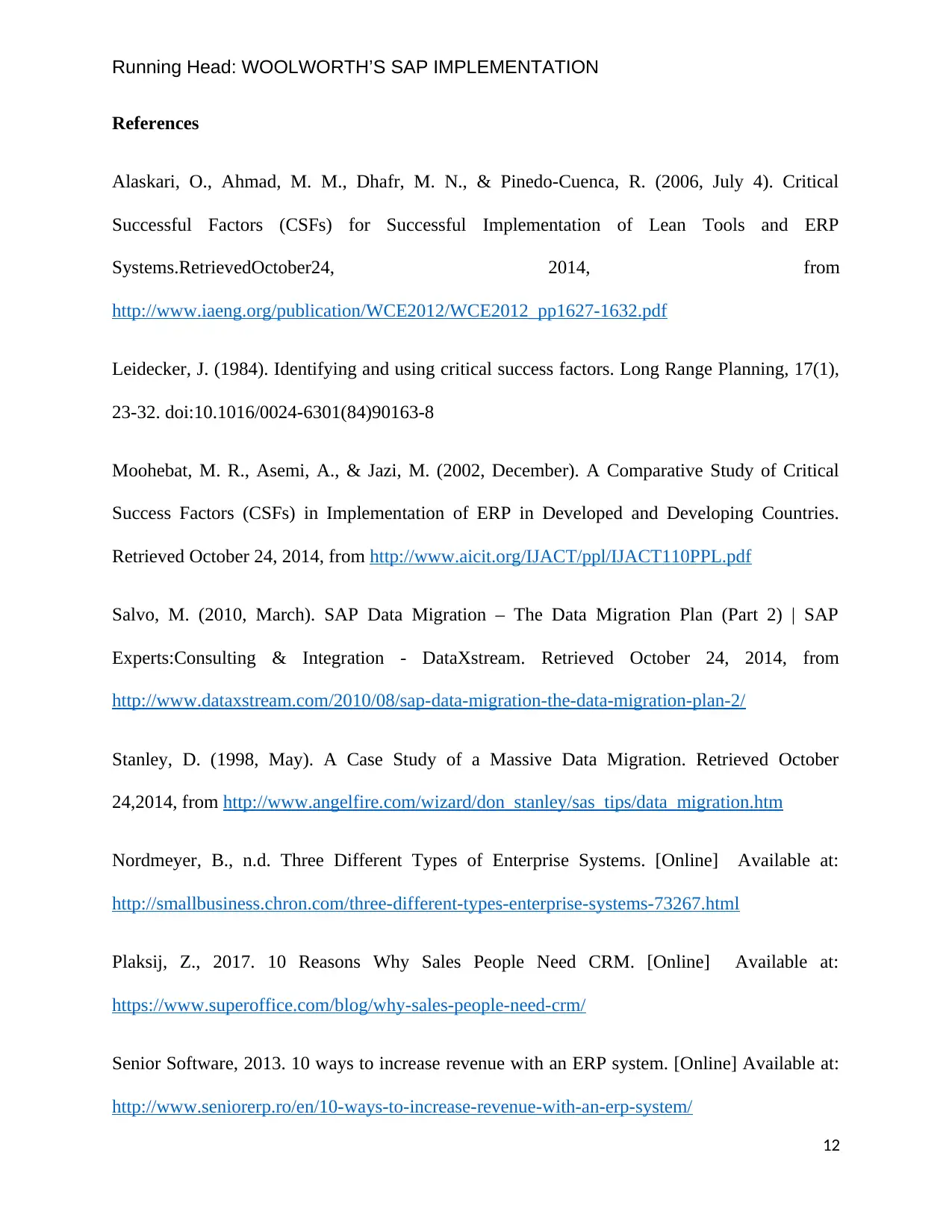
Running Head: WOOLWORTH’S SAP IMPLEMENTATION
References
Alaskari, O., Ahmad, M. M., Dhafr, M. N., & Pinedo-Cuenca, R. (2006, July 4). Critical
Successful Factors (CSFs) for Successful Implementation of Lean Tools and ERP
Systems.RetrievedOctober24, 2014, from
http://www.iaeng.org/publication/WCE2012/WCE2012_pp1627-1632.pdf
Leidecker, J. (1984). Identifying and using critical success factors. Long Range Planning, 17(1),
23-32. doi:10.1016/0024-6301(84)90163-8
Moohebat, M. R., Asemi, A., & Jazi, M. (2002, December). A Comparative Study of Critical
Success Factors (CSFs) in Implementation of ERP in Developed and Developing Countries.
Retrieved October 24, 2014, from http://www.aicit.org/IJACT/ppl/IJACT110PPL.pdf
Salvo, M. (2010, March). SAP Data Migration – The Data Migration Plan (Part 2) | SAP
Experts:Consulting & Integration - DataXstream. Retrieved October 24, 2014, from
http://www.dataxstream.com/2010/08/sap-data-migration-the-data-migration-plan-2/
Stanley, D. (1998, May). A Case Study of a Massive Data Migration. Retrieved October
24,2014, from http://www.angelfire.com/wizard/don_stanley/sas_tips/data_migration.htm
Nordmeyer, B., n.d. Three Different Types of Enterprise Systems. [Online] Available at:
http://smallbusiness.chron.com/three-different-types-enterprise-systems-73267.html
Plaksij, Z., 2017. 10 Reasons Why Sales People Need CRM. [Online] Available at:
https://www.superoffice.com/blog/why-sales-people-need-crm/
Senior Software, 2013. 10 ways to increase revenue with an ERP system. [Online] Available at:
http://www.seniorerp.ro/en/10-ways-to-increase-revenue-with-an-erp-system/
12
References
Alaskari, O., Ahmad, M. M., Dhafr, M. N., & Pinedo-Cuenca, R. (2006, July 4). Critical
Successful Factors (CSFs) for Successful Implementation of Lean Tools and ERP
Systems.RetrievedOctober24, 2014, from
http://www.iaeng.org/publication/WCE2012/WCE2012_pp1627-1632.pdf
Leidecker, J. (1984). Identifying and using critical success factors. Long Range Planning, 17(1),
23-32. doi:10.1016/0024-6301(84)90163-8
Moohebat, M. R., Asemi, A., & Jazi, M. (2002, December). A Comparative Study of Critical
Success Factors (CSFs) in Implementation of ERP in Developed and Developing Countries.
Retrieved October 24, 2014, from http://www.aicit.org/IJACT/ppl/IJACT110PPL.pdf
Salvo, M. (2010, March). SAP Data Migration – The Data Migration Plan (Part 2) | SAP
Experts:Consulting & Integration - DataXstream. Retrieved October 24, 2014, from
http://www.dataxstream.com/2010/08/sap-data-migration-the-data-migration-plan-2/
Stanley, D. (1998, May). A Case Study of a Massive Data Migration. Retrieved October
24,2014, from http://www.angelfire.com/wizard/don_stanley/sas_tips/data_migration.htm
Nordmeyer, B., n.d. Three Different Types of Enterprise Systems. [Online] Available at:
http://smallbusiness.chron.com/three-different-types-enterprise-systems-73267.html
Plaksij, Z., 2017. 10 Reasons Why Sales People Need CRM. [Online] Available at:
https://www.superoffice.com/blog/why-sales-people-need-crm/
Senior Software, 2013. 10 ways to increase revenue with an ERP system. [Online] Available at:
http://www.seniorerp.ro/en/10-ways-to-increase-revenue-with-an-erp-system/
12
1 out of 12
Related Documents
Your All-in-One AI-Powered Toolkit for Academic Success.
+13062052269
info@desklib.com
Available 24*7 on WhatsApp / Email
![[object Object]](/_next/static/media/star-bottom.7253800d.svg)
Unlock your academic potential
© 2024 | Zucol Services PVT LTD | All rights reserved.





